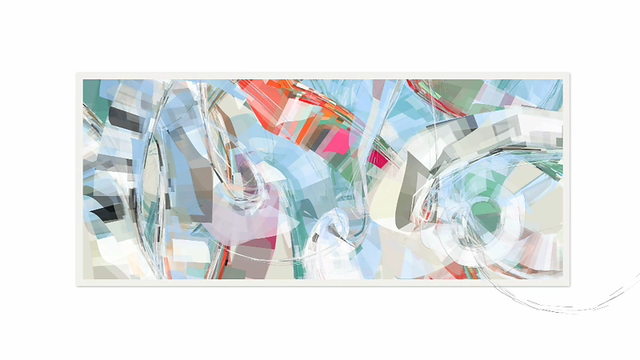I found Erik Natzke’s NextFest Exhibit A video inspirational. I admire the crossover between digital and physical (paint) methods of creating art. He is inspired by the organic strokes of paint and incorporates that into his digital work and capturing the movement of line and strokes. It is exciting to see how many images he can make with this canvas and the music that goes along with the piece brings out the exciting movement even further. I suppose that the algorithm used in this piece is animation, statements we have started to use in class in the draw function, which also definitely uses color, transparency and shapes. Erik’s artistic sensibilities show through in his algorithms with the way he animates the strokes to first be out of the picture frame and then almost throw into the picture frame. Also the way he makes up the strokes in smaller transparent shapes adds to the organic aspect of the lines.
Author: Arden Wolf
ardenw project 02 variable face
/* Arden Wolf
Section B
ardenw@andrew.cmu.edu
Project-02
*/
var num= (1);
function setup() {
createCanvas(350, 350);
}
function draw() {
if(num==1){
//angry face
background(66);
fill (255,0,0);
noStroke();
ellipse(200, 200,300, 200);
//eyes
fill(255);
stroke(152,8,8);
strokeWeight(5);
rect (100,200, 60,10);// left eye
rect (240,200,60,10);//right eye
//pupils
fill(0);
noStroke();
rect (100,200, 10,10);
rect (240,200,10,10);
//hilight
fill(255);
noStroke();
rect (100,200, 3,3);
rect (240,200,3,3);
//eyebrows
fill(152,8,8);
noStroke();
rect (100,190, 60,10);
rect (240,190,60,10);
//mouth
rect (170,250,60,10);
fill(0);
rect (180,251,40,6);
//ears
fill(152,8,8);
noStroke();
triangle(100,100,100,150,150,120);
triangle(300,100,300,150,250,120);
} else if (num==2){
//sad face
noStroke();
background(84,108,254);
fill (102,185,248);
ellipse(200, 150,200, 180);
//eyes
fill(200);
stroke (84,108,254);
strokeWeight (4);
ellipse (160,150, 40,20);// left eye
ellipse (240,150,40,20);//right eye
fill (0); //pupil
ellipse (160,150, 20,20);
ellipse (240,150,20,20);
fill(255); //hilight
noStroke();
ellipse(165,145, 10,5);
ellipse (245,145,10,5);
//mouth
fill(84,108,254);
ellipse(200, 200,50, 30);
fill (102,185,248);
ellipse(200, 210,50, 30);
}else {
//happy face
background(255,138,23);
fill (255,240,0);
ellipse(150, 150,200, 150);
//eyes
fill(255);
ellipse (100,150, 40,20);// left eye
ellipse (200,150,40,20);//right eye
fill (0); //pupil
ellipse (100,150, 20,20);
ellipse (200,150,20,20);
fill(255); //hilight
noStroke();
ellipse(105,145, 10,5);
ellipse (205,145,10,5);
//mouth
fill(255,138,23);
ellipse(150, 190,50, 30);
fill (255,240,0);
ellipse(150, 180,50, 30);
}
}
function mousePressed() {
num = num+1;
if (num==4)
{
num=1;
}
}For this assignment I decided to represent three emotions: Angry, Sad and Happy. I used if else statements and the variable num for function mouseIsPressed to change the faces and the background color to represent each emotion.
Looking outward- 01
GPS BeatMap
https://vimeo.com/6402527
In my concepts systems and processes class our teacher showed us the project GPS BeatMap. GPS BeatMap was a collaborative work by Rich Pell and Jesse Stiles created in 2006. It is a GPS music instrument that acts as a DJ booth for the whole planet. This can be accessed on foot, by plane, boat, car or train. They have musical phrases that are represented on a map as overlapping circular territories and where the territories overlap the BeatMap creates mash ups. Although I am interested in more visual topics rather than audio, I admire the fact that through computing an artist can create a dynamic interactive work where the possibilities are endless.
self portrait
function setup() {
createCanvas(350, 350);
background(0);
}
function draw() {
fill (45,34,30);//hair
stroke(45,34,30);
ellipse (200,230,310,400);
fill (255,205,148); //face
ellipse(200,200,230,300);
stroke (255,205,148); //neck
rect(148,290,98,90);
stroke(255,205,148) //ear
ellipse(80,200,60,80);
ellipse(315,200,60,80); //ear
fill (253,180,115);
ellipse (320,200,30,60);//inner ear
ellipse(70,200,30,60)
noFill();
stroke (209,119,0);//earrings
ellipse (320,265,35,60);
ellipse (80,265,35,60);
strokeWeight(4);
/*fill (139,0,0);//lips
stroke (139,0,0);
triangle(230,300,150,250,150,300);
fill (255,20,147);//inside
stroke (139,0,0);
triangle(230,300,150,250,150,300);*/
if (mouseIsPressed) {
fill (139,0,0);
stroke (139,0,0);
ellipse (200,290,80,80);
fill (255,20,147);
ellipse (200,290,79,79);
} else {fill (139,0,0);//lips
stroke (139,0,0);
triangle(230,300,150,250,150,300);
fill (255,20,147);//inside
stroke (139,0,0);
triangle(230,300,150,250,150,300);
}
stroke(253,180,115); //hairpart
line (200, 29, 200, 53);
//nose
fill(253,180,115);
ellipse (200,230,30,30);
ellipse (212,230,20,20);
ellipse (188,230,20,20);
rect(190,150,20,80);
stroke(255,205,148);
line (195,230,195,60);
//eyebrows
stroke(253,180,115);
rect (220,150,70,5);
rect (110,150,70,5);
//Eyes
fill(255,255,255);
rect (220,170,70,7);
rect (110,170,70,7);
fill (0,0,0);
stroke(0,0,0);
rect (222,172,3,3);
rect (112,172,3,3);
console.log("dsklhflasdh");
}
I had fun doing this assignment and seeing what I can create visually with code. I gave myself some attitude with a side eye look and I added an if mouse is pressed variable to show me talking.
![[OLD FALL 2018] 15-104 • Introduction to Computing for Creative Practice](../../../../wp-content/uploads/2020/08/stop-banner.png)
